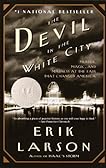
The Devil in the White City Murder, Magic, and Madness at the Fair that Changed America by Erik Larson
In his notes at the end of his 2004 book Devil in the White City, author Erik Larson says, "The juxtaposition of pride and unfathomed evil struck me as offering powerful insights into the nature of men and their ambitions."
This juxtaposition shapes this non-fiction work as Larson tells the story of the World's Columbian Exposition (the Chicago World's Fair of 1893) and the killing spree of H. H. Holmes, a psychopath who used the fair to feed his hunger to kill.
The White City is what the poet Carl Sandberg called "the hog butcher of the world," Chicago. Specifically, it is the grounds of the 1893 Chicago World's Fair, a wasteland that the Chicago architecht David Burnham and the landscape architect Frederick Law Olmstead turned into a vision of beautiful urban life. Here was a place (spray-painted white, hence the name) that gave birth to the incandescent light, Juicy Fruit chewing gum, shredded wheat, and more amid a neo-classical architectural wonderland that offered up the marvels of cultures from around the world. On top of that, it offered the newly-minted Ferris wheel, the brainchild of Pittsburgh, Pennsylvania, iron inspector George Ferris, who sought to out-Eiffel the designer of the Eiffel Tower, whose steel tower of steel surpassed the wild imaginings of even the most innovated American engineer of the time at the previous world's fair in Paris.
At the same time the planned city was emerging on the shore of Lake Michigan and allowing Americans to glimpse urban life as an aesthetically pleasing experience rather than a utilitarian hell, H. H. Holmes was piggy-backing on these developments to swindle men and seduce women out of his perverse craving for power. His story is as gruesome as it is evil. His fastidious exterior and his calculating mind allowed him to pursue his dark ends for years and at the expense of many lives. Ironically, as Burnham and his colleagues sought to raise tall buildings and elevate them as works of art, Holmes was building a dark castle that descended into the earth in a random, dark assemblage of windowless rooms, airtight vaults, and a gas chamber.
Holmes is not the only dark character in this book that reads like a novel as it describes the tug-of-war between artists, engineers, politicians, and laborers to be spectacular, but he is the darkest. The Chicago World's Fair was a marvel and a pleasure that came at tremendous expense. It rose on the shoulders of ordinary people in a relatively young country that accepted risk as a necessary part of progress. The Holmes story stands out in this landscape because he was not ordinary but exceptional. In the end, justice came to Holmes. And the world went on.
Larson's exploration of "men and their ambition" is a rich, compelling read.




Sandy Carlson Social